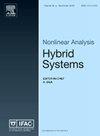Model predictive control of switched-actuator systems with setup times, and application to hyperthermia cancer therapies
IF 3.7
2区 计算机科学
Q2 AUTOMATION & CONTROL SYSTEMS
引用次数: 0
Abstract
A switched-actuator system with setup times (SAcSS) is a system in which the actuator configuration has to be switched during operation, and where the switching induces non-negligible actuator downtime. Optimally controlling SAcSSs requires the online solving of both a discrete actuator allocation problem, in which the switch-induced actuator downtime is taken into account, as well as an optimization problem for the (typically continuous) control inputs. Mixed-integer model predictive control (MI-MPC) offers a powerful framework for tackling such problems. However, the efficient modeling of SAcSSs for MI-MPC is not straightforward, and real-time feasibility is often a major hurdle in practice. It is the objective of this paper to provide an intuitive and systematic modeling procedure tailored to SAcSSs, which is specifically designed to allow for user-friendly controller synthesis, and to yield efficient MI-MPCs. We apply these new results in a case study of large-volume magnetic-resonance-guided high-intensity focused ultrasound hyperthermia, which involves the heating of tumors (using real-valued local heating controls, as well as discrete range-extending actuator relocation during which no heating is allowed) to enhance the efficacy of radio- and chemotherapy.
具有设置时间的开关致动器系统的模型预测控制,以及在热疗癌症治疗中的应用
具有设置时间的切换致动器系统(SAcSS)是一种在操作过程中必须切换致动器配置的系统,其中切换导致致动器不可忽略的停机时间。优化控制sacss需要在线解决离散执行器分配问题,其中考虑了开关引起的执行器停机时间,以及(通常是连续的)控制输入的优化问题。混合整数模型预测控制(MI-MPC)为解决这类问题提供了一个强大的框架。然而,针对MI-MPC的sacss的高效建模并不简单,实时可行性往往是实践中的主要障碍。本文的目的是为sacss提供一个直观和系统的建模程序,该程序专门设计用于用户友好的控制器合成,并产生高效的MI-MPCs。我们将这些新结果应用于大体积磁共振引导的高强度聚焦超声热疗的案例研究中,该案例涉及肿瘤的加热(使用实值局部加热控制,以及不允许加热的离散范围扩展驱动器重新定位),以提高放疗和化疗的疗效。
本文章由计算机程序翻译,如有差异,请以英文原文为准。
求助全文
约1分钟内获得全文
求助全文
来源期刊

Nonlinear Analysis-Hybrid Systems
AUTOMATION & CONTROL SYSTEMS-MATHEMATICS, APPLIED
CiteScore
8.30
自引率
9.50%
发文量
65
审稿时长
>12 weeks
期刊介绍:
Nonlinear Analysis: Hybrid Systems welcomes all important research and expository papers in any discipline. Papers that are principally concerned with the theory of hybrid systems should contain significant results indicating relevant applications. Papers that emphasize applications should consist of important real world models and illuminating techniques. Papers that interrelate various aspects of hybrid systems will be most welcome.
 求助内容:
求助内容: 应助结果提醒方式:
应助结果提醒方式:


